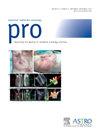治疗头颈部鳞状细胞癌的确定性放疗与顺铂每周注射一次:系统回顾与网络元分析》。
IF 3.5
3区 医学
Q2 ONCOLOGY
引用次数: 0
摘要
目的:头颈部鳞状癌患者在接受放射治疗的同时应用顺铂的时间安排仍存在争议。大多数机构采用每 3 周一次的高剂量 "栓剂 "计划或每周一次的低剂量计划。我们通过一项简化的网络荟萃分析对这两种方案进行了比较:我们进行了一项 PRISMA 一致性系统综述,以确定比较顺铂与西妥昔单抗治疗接受明确放射治疗的非转移性、局部区域晚期头颈部鳞癌的随机对照试验。包含初次手术或诱导治疗的试验均被排除在外。使用数字化仪从已发表的曲线中按事件提取患者生存时间,并与已发表的点估算值和危险比(HRs)进行验证。在频数主义框架下使用随机效应考克斯回归对生存率进行比较。对毒性和次要终点进行了定性分析。Cochrane方法评估了偏倚风险。分析计划已在开放科学基金会进行了预先登记:结果:共确定了五项随机试验,包括1678名患者。每周治疗方案和栓剂治疗方案的总生存率没有统计学差异(HR,0.90;95% CI,0.53-1.52,P = .345)。该 Cox 模型表明,对于队列中的普通患者而言,每周治疗方案与栓剂治疗方案的 5 年总生存率的绝对差异为 +1.2% (95% CI, -6.1%-+5.9%, P = .345)。不同方案的次要终点和毒性没有明显差异:西妥昔单抗试验提供的间接数据表明,顺铂治疗方案之间的差异并不明显。本文章由计算机程序翻译,如有差异,请以英文原文为准。
Weekly Versus Bolus Cisplatin Concurrent With Definitive Radiation Therapy for Squamous Carcinoma of the Head and Neck: A Systematic Review and Network Meta-Analysis
Purpose
The schedule of cisplatin concurrent with definitive radiation for squamous carcinoma of the head and neck remains controversial. Most institutions deliver either a high-dose “bolus” schedule once every 3 weeks or a low-dose weekly schedule. We compared these 2 schedules via a simplified network meta-analysis with a common comparator.
Methods and Materials
We performed a PRISMA–concordant systematic review to identify randomized controlled trials comparing cisplatin with cetuximab for nonmetastatic, locoregionally advanced squamous carcinoma of the head and neck treated with definitive radiation. Trials incorporating primary surgery or induction therapy were excluded. Patient survival times were extracted on a per-event basis from the published curves using a digitizer and validated against published point estimates and hazard ratios (HRs). Survival was compared using random effects Cox regression under a frequentist framework. Toxicity and secondary endpoints were analyzed qualitatively. The Cochrane method assessed the risk of bias. The analysis plan was preregistered with the Open Science Foundation.
Results
Five randomized trials were identified, including 1678 patients. There was no statistical difference in overall survival between weekly and bolus regimens (HR, 0.90; 95% CI, 0.53-1.52, P = .345). This Cox model suggested that for the average patient in the cohort, the absolute difference in 5-year overall survival between weekly and bolus regimens was +1.2% (95% CI, −6.1%-+5.9%, P = .345). Secondary endpoints and toxicity were not obviously different by regimen, qualitatively.
Conclusions
The cetuximab trials provide indirect data suggesting that the differences between cisplatin schedules are subtle.
求助全文
通过发布文献求助,成功后即可免费获取论文全文。
去求助
来源期刊

Practical Radiation Oncology
Medicine-Radiology, Nuclear Medicine and Imaging
CiteScore
5.20
自引率
6.10%
发文量
177
审稿时长
34 days
期刊介绍:
The overarching mission of Practical Radiation Oncology is to improve the quality of radiation oncology practice. PRO''s purpose is to document the state of current practice, providing background for those in training and continuing education for practitioners, through discussion and illustration of new techniques, evaluation of current practices, and publication of case reports. PRO strives to provide its readers content that emphasizes knowledge "with a purpose." The content of PRO includes:
Original articles focusing on patient safety, quality measurement, or quality improvement initiatives
Original articles focusing on imaging, contouring, target delineation, simulation, treatment planning, immobilization, organ motion, and other practical issues
ASTRO guidelines, position papers, and consensus statements
Essays that highlight enriching personal experiences in caring for cancer patients and their families.
 求助内容:
求助内容: 应助结果提醒方式:
应助结果提醒方式:


